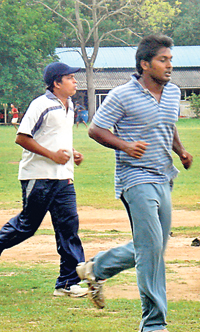|
This week we look at jogging, considered one of the best cardio vascular, full body work outs and we thought of giving you a few tips on jogging to assist you in doing your workout, in the most correct manner.
“A proper jog helps you to improve your cardiovascular effectiveness, burn calories increase your metabolism, reduce LDL (Low Density Lipoprotein) cholesterol and increase HDL (High Density Lipoprotein) cholesterol,” said, Major General (Dr) C. Thuriarajah, a well known sports physician adding, “Jogging helps in decreasing your pulse rate, helps reduce blood pressure and also reduces the risk of osteoporosis.”
It may all seem simple, just get on to the road or the grounds and start jogging however, what’s vital is that the work out must be conducted as a structured exercise with fitness as a goal, and only then will you be able to reap the benefits. Further the activity should be sustained for at least 15 to 20 minutes.
Major General Thuriarajah explained to us that ‘interval jogging,’ is also a good form of exercise which is practiced even by top athletes. Interval jogging is jogging at intervals while sustaining movement throughout. “One can jog and then slow down to a walk and then pick up pace again in to a jog while making sure there is consistent and constant movement during the work out,” Major General Thuriarajah said.
“Before you jog you should stretch and warm up properly for at least five minutes and when you finish jogging cooling down is equally important,” he said adding, “These are guideline to assist towards the best results.” Major General Thuriarajah went on to state, that such a routine must be on a regular basis along with a balanced diet.
The obvious health benefits aside in terms of psychological gains are, jogging helps reduce stress, improves ones problem solving ability and also increases self esteem.
Going into a few technical details, Major General Thuriarajah mentioned that in terms of aerobic fitness, there are 11 fitness forms of which cross country skiing (or working out on the cross trainer) falls in first place while the second place is taken by jogging followed by skipping in third position and walking comes in 11th place.
“It’s extremely important to wear the right shoes when jogging,” he stressed and in fact, there are different shoes which are designed specifically for jogging and walking, and to remember to choose what’s most suitable for your work out routine. Also make sure that your socks are cotton and porous.
The heel – toe method, is important when jogging as well as walking. What this means is that your heel should touch the ground followed by your toes. While jogging your foot should point straight, chin must be up and shoulders relaxed. The core muscles, that of your stomach and lower back must be kept in and elbows close to the body.
Ideally, the best method is to breathe through your nose and out through your mouth, however what ever allows you to be relaxed, when breathing, will work fine, too.
Some common injuries caused during jogging are as follows:
- Blisters/foot blisters – This can be avoided by wearing proper shoes and socks. If it occur what’s best is to pierce it with a sterilized needle and let the fluid out and put a doughnut shaped protective covering around the blister.
- Muscle cramp – Can be prevented by drinking a lot of water, warming up and stretching properly before activity. However, if a cramp arises it is best to stop the activity and gently massage the area and stretch.
- Shin splints – Can be identified due to acute pain in the front of the leg. These injuries can be prevented by wearing proper shoes. If it occurs one should temporarily discontinue the activity or switch to an alternative activity such as cycling or swimming until it heals.
- Achilles tendonitis – The Achilles tendon is the largest tendon at the back of the ankle and such an injury can be identified when swelling and pain occurs over this tendon during exercise. It can be treated by stretching properly and following a proper strengthening programme of the core muscles.
The RICE Regime is a set of guidelines which can be followed in the case of a sports injury, which is as follows:
Rest – Stop the activity as soon as you notice the injury (not pain).
Ice – Immediately place an ice pack on the affected area to reduce the swelling. This should be done for 10 – 20 minutes and repeat it once in two hours.
Compression – Bandage the area and loosen it every half an hour to one hour
Elevation – Elevate the area above the heart level until the swelling subsides. |
|

